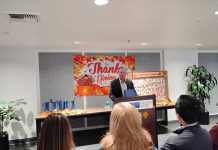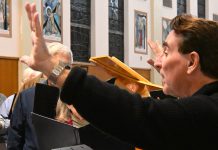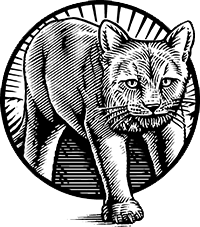
New Museum Los Gatos (NUMU) last week unveiled “Ebb & Flow,” its newest exhibition, featuring three artists—Cheiko Shimizu Fujioka, Moekoa Machida and Margaret Luo—who worked with museum curators to create four distinct artworks, including one collaborative piece titled “Interwoven Elements.”
Located just by the entrance to the museum at the Mike & Alyce Parsons Reception, the artworks of “Ebb & Flow” are held together on a backdrop with connective elements drawn by graphic designer Qiuwen Li and a synopsis of the exhibition written by curator Allison Railo.
Guests from around Los Gatos and Saratoga were treated to an opening reception with food and drinks, during which Fujioka and Luo spoke about the exhibition and collaborative process. Machida, who currently lives in Switzerland, made a video appearance to share appreciation for the museum and her collaborators.
Saratoga resident Judy Goldman, who has seen many of Luo’s works in the past, attended the reception with her husband. “I wanted to come support a local museum and appreciate how the museum has opened its doors to emerging artists,” she said.
According to a July 10 press release, the exhibition “explores the artistic process of three individual artists who found a connection through their shared Asian cultures and ‘creational philosophy’ of their art practices.”
“Interwoven Elements,” which features contributions from all three artists, was the first artwork they completed, taking almost an entire year to finish. According to Luo and Fujioka, this was their second attempt at a collaborative piece; all three of the artists decided to restart after being unsatisfied with their first try.
After the completion of “Interwoven Elements,” each artist also created a piece for the exhibition reflecting their individual styles. Railo, who worked with the artists throughout their collaboration with the museum, says that this exhibition is a rare example of artists working alongside the museum through the entire creative process rather than submitting finished works of art.
Luo, a self-taught Chinese-American artist who left her job as a policy researcher in 2022 to pursue art full-time, contributed an oil painting titled “Great Waves of the Moon.” Inspired by coastal scenes from the Bay Area and her childhood, Luo says she has always tried to emulate the calmness of ocean waves through her paintings.
“As someone who is very stressed out all the time, I felt like water really spoke to me…if you paint something serene, you feel serene,” Luo told the Los Gatan during the reception.
Fujioka, a Japanese artist specializing in an abstract form she calls “glass mosaic,” contributed a mosaic titled “After Dark.” During her remarks at the reception, she noted that the piece is meant to capture the idea of finding hope in darkness.
Glass mosaic art starts with an acrylic painting on a wooden base specially carved out for each piece, after which the artist smashes a glass sheet and arranges the broken shards like puzzle pieces on top of the painting, using grout to cover the finished product and hold everything together.
Fujioka told guests that, for her, this process of breaking-and-reshaping symbolizes hope; in particular, the broken glass coming together to form a strong product represents human resilience.
Finally, Machida, a Japanese artist who specializes in using materials like mineral pigments and gold leaf, contributed “Form of Life.”
Raised by biologist parents, Machida’s work explores “the preciousness of life, drawing viewers into a realm of existence that persists beyond the boundaries of this world,” according to her website. Luo described “Form of Life” as exploring “life cycles, death and vitality.”
Each artwork in the collection is labeled by a Kanji character on top of its English name—a choice, the artists explained, made to bridge their Chinese and Japanese heritages, as Kanji characters are often borrowed from Mandarin but have unique meanings in Japanese. For instance, “Interwoven Elements” is labeled “交,” the character for “exchange.”
To accompany their work, the artists also created a display, located in the middle of the exhibit, showcasing their artistic processes and the different techniques each of them use with a pile of glass shards, an oil paint palette and samples of mineral pigments.
The display also includes 15 Polaroid photographs, also labelled with Kanji characters, which the artists took as an exercise to find visual inspiration for the collection.
Although all three artists had previously known each other through the San Jose arts community, they all found this year-long collaboration to be uniquely challenging and transformative in its own ways.
For Fujioka in particular, that meant letting go of previously held rules in how she approaches the artistic process and exploring different forms of expression, a perspective which she hopes to carry past this exhibition and into future collections.
Regardless, all of the artists expressed their appreciation for the museum and for each other in their remarks.
“The work came out in an unexpected way,” Machida said in her video message. “I couldn’t be happier with what we created together.”
Fujioka and Luo will be hosting a free artists’ tour at the museum on Aug. 3 and a workshop on their collaborative process on Oct. 4. “Ebb & Flow” is open to the public until Jan. 4, 2026.









